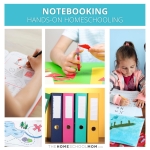Unit studies make it easy to teach different ages at the same time by using a multi-level strategy. They can be hands-on, literature-based, or even nature-based.

Experience tell us that the most important educational lesson we can teach early learners is to fall in love with learning itself. ~ Steve Lambert
Unit studies typically encompass all of the scholastic subjects through the study of one topic (Weaver units or KONOS character units, for example), although they can be specific to a specific subject (like Evan-Moor science units or Teacher Created Materials units). Since it is easier to teach different ages the same topics with multi-level unit studies, they are popular among homeschoolers wanting to keep all of their children on similar topics at the same time.
Insight into using unit studies
Notebooking, lapbooking, timelines, and other resources are often used in conjunction with unit studies. You can read more about those topics, learn more about specific unit study curriculum providers, and more below.
Introduction to the Unit Study Approach
 Unit studies, sometimes called thematic units or integrated studies, are very popular with homeschoolers. Unit studies usually use a hands-on approach for effective learning. The child learns by actually experiencing or discovering through different methods and activities, rather than just reading a chapter from a textbook. Studies show that children using unit-study methods retain 45% more than those using a traditional approach.
Unit studies, sometimes called thematic units or integrated studies, are very popular with homeschoolers. Unit studies usually use a hands-on approach for effective learning. The child learns by actually experiencing or discovering through different methods and activities, rather than just reading a chapter from a textbook. Studies show that children using unit-study methods retain 45% more than those using a traditional approach.
Lapbooks
 Lapbooks are paper manipulatives using file folders in which the student stores creative summaries of their work. The concept is similar to notebooking and some notebooking resources can be used in lapbooks, but the concepts do differ. Lapbooks are more than just notebooks with collections of worksheets, they are diagrams, minute books, and other paper manipulatives customized to emphasize the subject of the lapbook.
Lapbooks are paper manipulatives using file folders in which the student stores creative summaries of their work. The concept is similar to notebooking and some notebooking resources can be used in lapbooks, but the concepts do differ. Lapbooks are more than just notebooks with collections of worksheets, they are diagrams, minute books, and other paper manipulatives customized to emphasize the subject of the lapbook.
Notebooking
 Notebooking and lapbooking are closely related. Notebooking is a bit simpler, with the information inserted into simple 3-ring binders instead of put into the more elaborate lapbooks. Notebooks are put together using maps, lab reports, scrapbook pages, worksheet pages, drawings, essays, timelines, and any other relevant work that your child creates.
Notebooking and lapbooking are closely related. Notebooking is a bit simpler, with the information inserted into simple 3-ring binders instead of put into the more elaborate lapbooks. Notebooks are put together using maps, lab reports, scrapbook pages, worksheet pages, drawings, essays, timelines, and any other relevant work that your child creates.
Timelines in the Homeschool
 Timelines offer students the ability to visually process overlapping and chronological events in history, relating them in a way that is more difficult to perceive through reading. Timelines in the homeschool are a valuable tool to relate subjects together and view historical events as interrelated.
Timelines offer students the ability to visually process overlapping and chronological events in history, relating them in a way that is more difficult to perceive through reading. Timelines in the homeschool are a valuable tool to relate subjects together and view historical events as interrelated.
Delayed Academics: It's All About Learning

Contextual Learning: Homeschooling Through Fashion
 Contextual learning with fashion works no matter what the approach to education—but homeschooling provides the time and flexibility to pursue passions.
Contextual learning with fashion works no matter what the approach to education—but homeschooling provides the time and flexibility to pursue passions.
Kids Blogging Unit Studies

Help Your Homeschool with Rabbit Trails
 Homeschooling is boring, your child is resistant, the curriculum seems “complete” but moves on quickly and without depth. You can improve this kind of homeschool experience by opening yourself to following the rabbit trails.
Homeschooling is boring, your child is resistant, the curriculum seems “complete” but moves on quickly and without depth. You can improve this kind of homeschool experience by opening yourself to following the rabbit trails.
Reviews of Unit Study Resources For Homeschooling
Suggested books
Unit Studies Made Easy by Valerie Bendt
From amazon.com Valerie's popular book How to Create Your Own Unit Study is back! This updated, expanded version includes all four of Valerie s previously published unit study books in one big volume: How to Create Your Own Unit Study, The Unit Study Idea Book, For the Love of Reading, and Success with Unit Studies.
Home Learning Year By Year by Rebecca Rupp
This is a helpful reference resource for homeschoolers using unit studies since it covers what is typically taught by grade and subject.
From amazon.com Finally, homeschoolers have a comprehensive guide to designing a homeschool curriculum, from one of the country's foremost homeschooling experts. Rebecca Rupp presents a structured plan to ensure that your children will learn what they need to know when they need to know it, from preschool through high school.
Unit study resources from other websites:
Homeschooling Styles: Unit Studies is an article about unit studies by Valerie Bendt archived from Weird Unsocialized Homeschoolers
Big List of Unit Study Hands-On (and Hands-Off) Curriculum by Tina's Dynamic Homeschool
The Ultimate Guide To Planning a Homeschool Unit Study from Jessica at The Waldock Way
Homeschool Helper Online
Homeschool Helper Online has currently free units available through the site, each of which has corresponding worksheets and library lists. They also offer lapbooking and notebooking resources.






